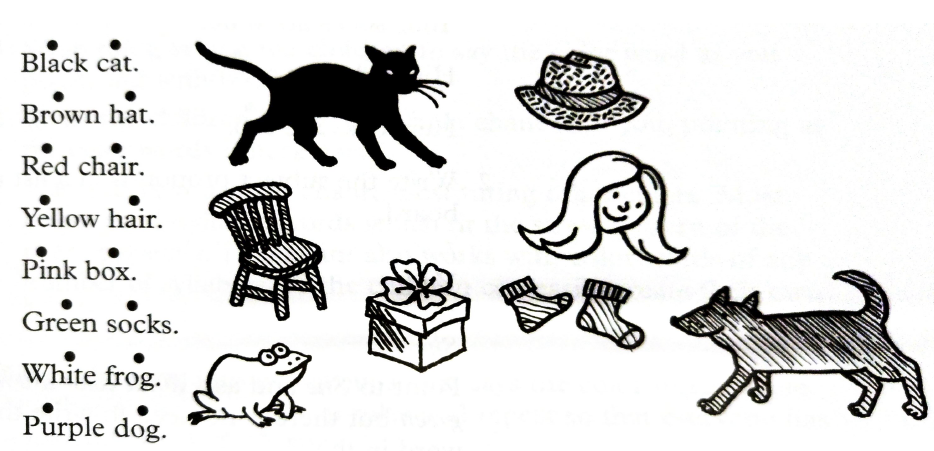
Purpose of Foreign Language Activities/ Subject
Students should EXPERIENCE the foreign language by
- Listening, understanding, and thinking
- Reading, understanding, and thinking
- Communicating with classmates, teachers, ALTs, visitors, etc.
- Writing for communication
To fulfill the above purpose, we will study:
- How to make the language in authentic materials understandable.
- How to give students output activities.
Today’s Outline
- Overview of CLIL
- Overview of Bloom’s Taxonomy ( ブルームの目標分類学 )
- Using Bloom’s taxonomy to plan song and picture book activities.
Click here for the Participants’ page (参加者用のページがこちらにあります)
Background
Overview of CLIL
Let’s do a quiz! Click this link!
Overview of Bloom’s Taxonomy of Cognitive Processes
Let’s review the different levels here.

Songs
- All songs are from
- Graham, C. (2006). Creating Songs and Chants. Oxford University Press
1. Purple, yellow
Objectives
- Explain the colors and words in the song
- Carry out own original chant.
Possible procedures
- Listen to the song. Pick up each color as you hear it.
- Which two colors do you hear the most?
- What other colors did you hear?
- We will listen one more time. Find the words that rhyme with the colors. (色の言葉と韻を踏む言葉を見つけて下さい)For example “white” rhymes with “fight”.
- Let’s create our own chant.
*Graham (2006), p.60
Lyrics
2. Black cat
Objectives
- Recall the words in the song
- Carry out own original chant.
Possible procedures
- Tell students to listen carefully to the chant because you will play a memory game.
- Say a color/object and have children say the other word: e.g. red = chair to encourage children to produce “adjective + noun” phrase.
- When you have reviewed all the phrases in this way, write one list of words (either colors or objects) and have children say the chant.
- Create your own chant substituting the words.
* Graham (2006), pp.64-65
Lyrics
Books
Fast-slow, high low (Spier, Peter, World’s Word Children’s Book)
- Language: Opposites, adjectives
- Topic: All things around us
Objectives
- Recall how to say various objects in one’s daily life.
- Use adjectives to describe objects in one’s daily life.
Possible procedures
- Point to pictures and elicit the adjectives and the names of objects.
- Play the pointing game.
- Challenge students to say the names for as many objects as possible on a page.
- Say an adjective (Big/small, Long/short) and students must point to something in the room.
One Green Island
- Language and topics: Animals, adjectives, actions
Objectives
- Infer the names of the animals and the meaning of the adjectives that describe them.
- Look at the pictures and read the story.
Possible procedures
- For each page.
- Say the number and have the students guess the animal.
- Read the page and have students guess the adjective: happy, tall, slithery, etc.
- Have students say the Island/ animals from the previous page.
Glad Monster, Sad Monster (Emberley, Ed & Miranda, Anne, 1997)
Possible procedures
- Read each page and confirm students’ understanding.
- Put on the mask after each page and say what makes you glad, angry, etc.
- Ask some students to say what makes them glad, etc. Students can discuss this in pairs/ groups.
- Call on some students to put on the mask and act out what makes them glad/ angry, etc.
- Please note: this should probably be done with only a few pages at a time.
Ketchup on your cornflakes
- Language: Do you like? Prepositions, as students
- Topic: We can 2, Unit 8 What would you like?
Objectives
- Infer the meaning of the objects as well as the meaning of the preposition.
- Make one’s own silly combinations.
Possible procedures
- Teacher reads the book.
- Students read the book
- Students make similar questions with their own ideas, perhaps also with pictures.
Don’t eat your classmates!
Objectives
- Listen to the story and students explain the basic outline in pairs.
Possible procedures
- Listen to the story and enjoy it!
Books James Recommends
*=小学校で実施したことがあります。


[…] Workshops on using chants and picture books […]